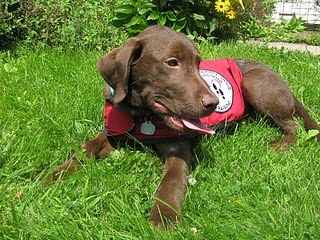My colleague Lisa Collier Cool posted a nice piece on the HealthyMagination Blog in July about animal-assisted therapy (AAT) at a children’s hospital in Columbus, Ohio. It got me thinking.
Do you know the difference between a therapy dog, a service dog, and a dog who does animal-assisted therapy?
It’s really pretty interesting.
Therapy dogs visit hospitals, children’s centers, and nursing homes to visit and be loved upon and such.

Service dogs actually work with their assigned person by assisting them with any number of tasks. (These are dogs like the ones raised by people such as Laurie at Smart Dog University and Laura at The Dogs are Really in Charge.)
But, animal-assisted therapy dogs (like the ones Lisa profiles) are essentially employed by the hospital, where they help various patients with specific rehabilitation tasks:
- Learning to speak again
- Regaining arm or leg coordination by throwing or kicking the ball with the dog
- Sitting still during therapy
Sometimes, the dogs work during the therapy. Other times, they serve as “rewards” to the kids in the program.
I cannot imagine a greater motivator than one attached to a wagging tale.



It is fitting that you posted this smack dab in the middle of “National Assistance Dog Week”. I am amazed every day by the dogs at my work. Here at Southeastern Guide Dogs, we breed, whelp, raise and train dogs to act as guides for the visually impaired.
The word “awesome” is overused in society, but it is absolutely fitting for our dogs as they sincerely inspire awe. It is such a remarkable responsibility that these dogs take on with want of nothing in return.
I was also involved in animal assisted therapy for a number of years at Vinceremos Riding Center where students with physical and mental impairments vanish when they are aboard a horse.
I am lucky to be surrounded by such amazing animals!
Funny, Jennifer. I didn’t realize until later that it indeed was National Assistance Dog Week.
I have always wanted to have a dog I could volunteer to visit hospitals and nursing homes with but have not had one with the right level of calmness and obedience. Probably my fault for not working harder on training. And I find the animal assisted therapy fascinating. If only I’d known about that one when I went to college. I would have loved it.
I know … doesn’t it sound like a great way to work? You can always reinvent your career, Mary!
I know the difference between therapy and service dogs, but never heard of animal-assisted therapy dogs. A lot of people keep urging me to combine my love of animals with my major, psychology – I have a feeling that this is what they’re talking about.
That would be a terrific career path to explore, Sam. I know that we and all our mutual dog/blog friends would support the idea. There is a really good master’s program along these lines at the University of DENVER!!!! Check it out.
It’s Chuck!!! There really are a lot of people who have no clue about the difference between therapy dogs and assistance dogs and I actually get stopped quite a bit by people who want to know how they can get their dog to go out in public too. There’s not a lot of facility based dogs but I think that those dogs are super cool. They have to have such a stellar temperament and be even more bomb proofed then other assistance dogs!
Chuck! Chuck! Chuck! — Laura … I hope you don’t mind me grabbing that photo of your little stinker. It sounds like his training is going well.
I know how hard service dogs have to work. I cannot even imagine the skill dogs would need to work with SO many different people, like at a facility. Crazy!
I just wrote an article for New Jersey Life Health + Beauty magazine about therapy pets and realized I needed to explain the difference between animal-assisted activities and animal-assisted therapy. All the animals involved in this type of work are so special!
Congrats, Alison, on the assignment. I think it’s really neat that dogs with such solid temperaments and training can work in these fields. It’s just wild what they can accomplish.
I am in awe over these dogs and how much they can help people live more normal lives. I spent some time writing about Guiding Eyes and the time spent there, not only observing the training of the dogs but then watching them paired with their new owners was absolutely heartwarming and amazing.
Sheryl — I highly recommend the novel Around the Next Corner. One of the main characters is a service puppy / guide dog puppy in training.
What a wonderful contribution these dogs make to the lives of those they assist. My dog isn’t trained in any special way, but she still is a great motivator with a wagging tail!